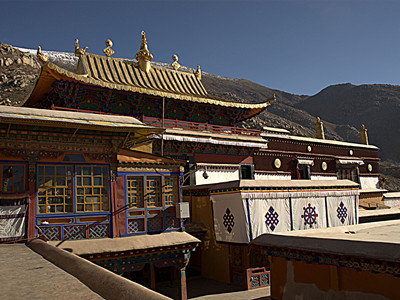Drepung Monastery [ Related Itinerary ]
 Located 5 kilometers from the west suburb of Lhasa city, Drepung Monastery is one of the world’s largest monasteries and one of the famous "Three Great Monasteries" in Tibet. It suffered through the ages with assaults by the kings of Tsang and the Mongols, but was left relatively unscathed during the Cultural Revolution and there is still much of interest intake. Rebuilding and resettlement continue at a pace unmatched elsewhere in Tibet and the site once again resembles a small village, with around 600 monks' resident. The best way to visit the chapels is to follow the pilgrims or, failing that, the yellow signs.
Located 5 kilometers from the west suburb of Lhasa city, Drepung Monastery is one of the world’s largest monasteries and one of the famous "Three Great Monasteries" in Tibet. It suffered through the ages with assaults by the kings of Tsang and the Mongols, but was left relatively unscathed during the Cultural Revolution and there is still much of interest intake. Rebuilding and resettlement continue at a pace unmatched elsewhere in Tibet and the site once again resembles a small village, with around 600 monks' resident. The best way to visit the chapels is to follow the pilgrims or, failing that, the yellow signs.Drepung Monastery was built in 1416 by Tsong Khapa's disciple Jamyang Qoigyi. After the establishment, it soon became the mother temple of Dalai Lamas. In 1546, the third Dalai was welcomed as the first Living Buddha into it. He was dignified with the title 'the third Dalai Lama' and went to Qinghai Province to preach. It is the very place that the second, third, and the fourth Dalai Lama held the Sitting-in-Bed Ceremony, as well as the residence of the fifth Dalai before his nomination by the government of the Qing Dynasty (1644 - 1911).
Drepung has tight structures, temples and groups of buildings cascading, each building unit is basically divided into three levels, which are the courtyard, church and Buddhist Prayer Room, formed layer by layer from the gate to the Buddhist temple elevated pattern, to emphasize and highlight the Buddha's noble status. Among them the large-scale, magnificent stately palace is Cuoqin hall. There are thousands of ancient artifacts collect in Drepung Monastery. Temple provides various kinds of statues of different times all of which have an air of lively, well-structured, represent the high level of Tibetan sculpture. Crafts and colorful murals of the temple have strong lines. In addition, Drepung Monastery has a collection of Buddhist scriptures "Kanjur" and Buddhist commentaries "Kanjur" of more than 100, as well as mentoring and other writings of Tsongkhapa, three hundred manuscripts of the Department of Buddhist scriptures. All of these are hard-working wisdom of the Tibetan; make a great contribution to the study of Tibetan history, religion, art and other disciplines. They are of great value.
Paying a visit to Drepung Monastery, visitors will get a deeper understanding about Tibet custom and culture. So never miss the chance!
Related Itinerary